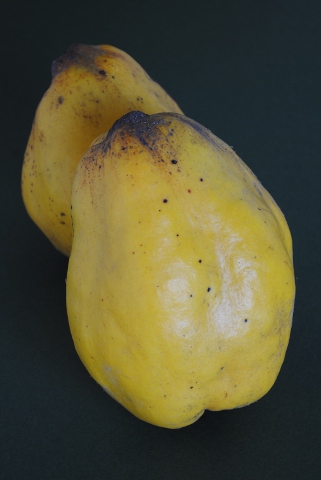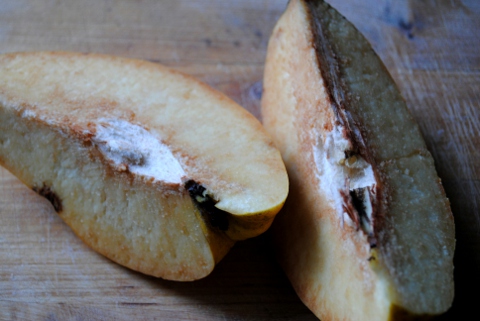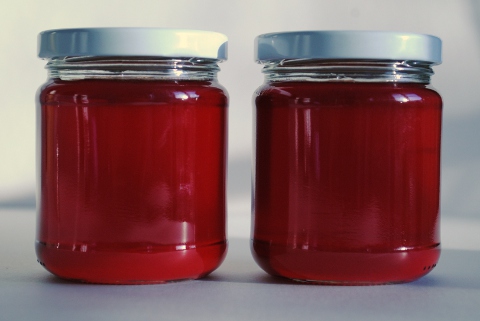Quince jelly
Quince are not a commonly-found fruit in Britain, but I’m fortunate enough to live close to a country estate with a handsome Victorian walled garden that plays host to two mature quince trees. The garden also harbours numerous different varieties of apple and pear, and the estate sells the fruit for a donation to the upkeep.
Quince look like giant yellow pears but are inedible raw, the flesh being very hard. They make beautiful jelly, however, and quince cheese or membrillo, which is particularly associated with Spain and Portugal. You can also use the fruit of the Japanese quince, chaenomeles japonica, which is an ornamental shrub related to the quince proper. Quince have an amazing smell that is hard to describe – ‘perfumed’ is the word that springs to mind – and although the flesh is pale, it cooks down to create a brick-red juice.
Quince have an amazing smell that is hard to describe – ‘perfumed’ is the word that springs to mind – and although the flesh is pale, it cooks down to create a brick-red juice.
To make jelly cut the whole quince into chunks. Cut out any rotten material, but don’t bother removing the skin, pith or seeds. Be careful cutting the fruit: even a sharp chef’s knife will have trouble going through it, so you need to use a lot of force. A meat cleaver would probably to the job better, if you have one.
The flesh browns very quickly on exposure to air – don’t be put off by this. Put the fruit into a heavy-based pan and add just enough water to cover. Then bring to the boil, turn the heat down and simmer until it is soft. This can take an hour or so.
 Once cooked, strain the juice through a perserving bag into a clean pan or other suitable container. Empty the fruit pulp into the bag and leave it to drain overnight. Having a proper stand like this one from Tala makes life easier, but there are various ways to rig a substitute if you’re imaginative. If flying insects are likely to be a problem I cover the pan and strainer with a tablecloth, although quince are an autumn fruit and I’ve not had a problem so far.
Once cooked, strain the juice through a perserving bag into a clean pan or other suitable container. Empty the fruit pulp into the bag and leave it to drain overnight. Having a proper stand like this one from Tala makes life easier, but there are various ways to rig a substitute if you’re imaginative. If flying insects are likely to be a problem I cover the pan and strainer with a tablecloth, although quince are an autumn fruit and I’ve not had a problem so far.
Weigh the juice you have extracted. For every 100g of juice, add 85g sugar. Ordinary white sugar will do, although preserving sugar is better. The crystals are larger than normal and dissolve more slowly, which helps bring impurities to the surface of the liquid during simmering. Quince already contains pectin, the chemical that causes jam and jelly to thicken, so there’s no need to use jam sugar.
Bring the juice slowly to the boil, making sure all the sugar is dissolved. Keep the juice on a rolling boil for 10-15 minutes. A rolling boil is when a liquid is bubbling constantly but not frothing up out of the pan. Take care with it – the liquid is sticky and will cause a nasty burn if you get any on you.
To determine when the jelly is ready, scoop a little out with a teaspoon and dribble it onto a plate. Within a minute or so it will cool and, if the ‘set point’ has been reached, form wrinkles when you poke it with a finger. If you chill the plate in the fridge beforehand, it will cool and set more quickly. If at first the jelly doesn’t set, keep boiling for a few minutes more and repeat the test.
Once you reach the set point, pour the jelly into sterilised jam jars and put the lids on immediately before leaving to cool. Perfect with English muffins, but also an interesting accompaniment to pork or a good strong Cheddar. Enjoy!
